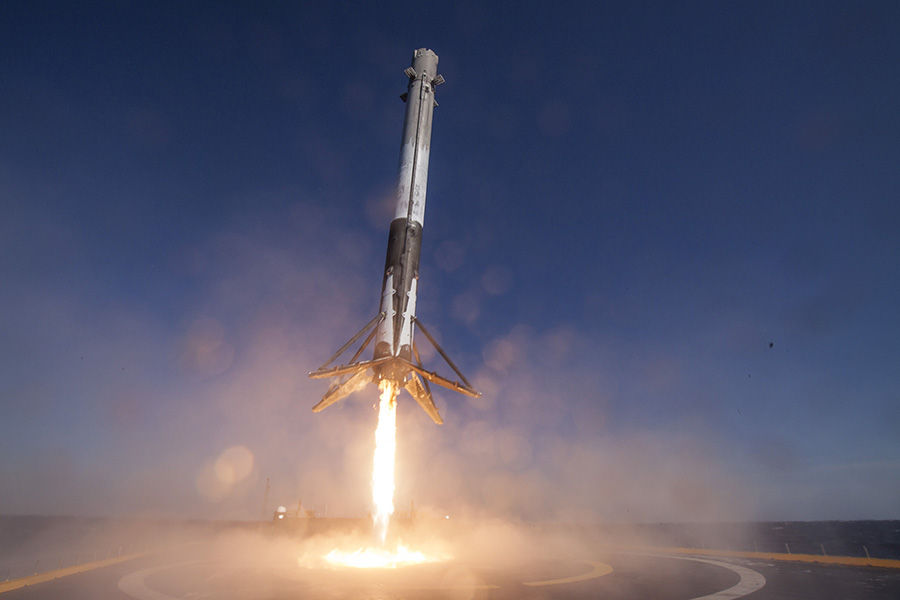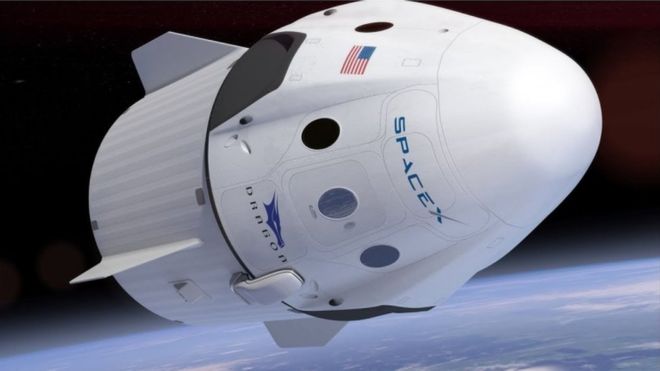Space X – The Falcon 9 Rocket
SpaceX is one of the leading commercial companies involved in the hotly contested race for space. Founder and majority shareholder Elon Musk has been using his billions wisely to build up his space technology empire, with the Falcon 9 rocket being the foundation of his considerable record of successful launches.
In fact though, the Falcon 9 is not a single rocket but a whole family of slightly different and gradually upgraded models. As a collective, it has undoubtedly been the workhorse of the company. The vast majority of the company’s launches have been made using this highly efficient and effective group of rockets.
It may not be the most famous in the space industry – people remain far more aware of NASA’s iconic but now defunct Apollo and Space Shuttle brands, and the still in use but ageing warhorse from the Soviet Union era, Soyuz. But many would be surprised to know that at the time of writing the various incarnations of the Falcon 9 rocket have already been used more than seventy times to send satellites and other payloads into space. It has also been used on several occasions to re-supply the International Space Station (ISS), ferrying supplies and equipment to the astronauts and cosmonauts on board.

Falcon 9 – A History
The roots of the rocket can be traced back to 2005. This was when SpaceX began development of its new launch vehicle. The name was conceived partly as a tribute to George Lucas’ Star Wars films, being named after the iconic Millennium Falcon star ship. The ‘9’ comes from the nine engines used to power the first stage of the rocket. The first Falcon 9 launch came in June 2010. This initial Falcon 1.0 version flew five times in around three years, before being retired and replaced with an upgraded model.
v1.0
The original v1.0, like all of its various versions, was a two stage rocket powered by its nine Merlin C1 rocket engines (also developed by SpaceX). These produced around 125,000 lb force of thrust from each engine. The total thrust available to this rocket at take-off was therefore well over a million pounds force. The second stage was powered by a single Merlin C1, this time modified to enable operation in the near vacuum of space.
This rocket worked well enough, but the original plan was for it to be reusable. This proved to be impractical, so a new design was required.
v1.1
The Falcon 9 v1.1 represented a very significant upgrade on the original model. Virtually every aspect of the rocket was improved and enhanced. The first stage again consisted of nine rockets, although this time the enhanced Merlin 1D model was used. Not only was this rocket more powerful, but their configuration was altered to enhance stability. Instead of being laid out in a square 3 x 3 orientation as on the v1.0, they were set up in an octagonal pattern. This had eight engines forming a circle around a single central unit. The fuel tanks were also expanded, being more than half as long again as the originals.
All these significant alterations meant that the new model was 60% heavier than the initial version, but with 60% more thrust as well. The v1.1 could produce more than 1.5 million lb force as it rose through the atmosphere into the thinner air. The expanded fuel tanks meant that it could also maintain its power for longer too. This increased power capacity meant that the rocket could carry more weight. Its payload capacity rose by almost 50%, from 9,000 kg to over 13 kg.
The two stages were now also fully returnable via powered re-entry. Extendable carbon fibre legs were attached for use when return landings were to be attempted.
The first launch of the new v1.1 upgrade came in September 2013. It flew fifteen times, before itself being superseded by its successor v1.2. Its final flight came in January 2016.
v1.2 Full Thrust
Compared to the previous upgrade, this was a more muted affair, more akin to the kind of model refreshes you see in the car industry. The most important difference is the addition of a cryogenically cooled fuelling system. This means that the density of the propellant can be increased, so a greater volume of fuel can be packed into the same sized storage tank. The second stage fuel tank was also increased in capacity. This fuelling upgrade gave the Falcon Full Thrust an additional 17% of thrust.
This version of the Falcon 9 took its maiden flight in December 2015. It has now been used more than fifty times and remains a highly effective rocket, still in use at the time of writing. The first stage has been successfully returned to earth 22 times, representing an almost 50% reusability rate. The ambition to also return the second stage for re-use has been abandoned on cost and efficiency grounds: too much payload capacity would be lost in adding the additional equipment and heat protection required to bring the second stage back from its higher altitude.
Further minor upgrades have continued for this rocket, but the basic Falcon 9 configuration and construction remains the same. The current model being used for flights at the time of writing is the Falcon 9 Full Thrust Block 5.
Falcon 9 Success Rate
With the number of launches heading toward three figures, the Falcon 9 has built up enough of a track record for us to properly evaluate its reliability. And it has to be said that this examination shows it is very good – certainly bearing comparison with other frequently used launch systems.
Out of the 71 launches attempted by the time of writing, 69 were successful. Just one rocket was destroyed in action, while one more was lost on the launch pad during a refuelling accident. This represents a 97.2% success rate. This compares well with alternative rocket systems. The most used rocket of all, Russia’s Soyuz, has conducted over 1700 launches, with an overall success rate of 97.4%.
Indeed, to maximise the prospects of a successful mission, the Falcon 9 has an additional safety feature which is lacking on many of its rivals. All launches are held down, preventing take off after full engine ignition in order to ensure that all systems are working properly before releasing the rocket from the launch pad. Any anomalies result in the aborting of the mission and immediate unloading of propellant from the fuel tanks. All rockets are also test fired before launch date to ensure everything is in working order.
Operational Record
As a true workhorse, the Falcon 9 has been used for many different purposes. It is capable of inserting satellites into all kinds of orbits. It is frequently used to launch satellites into low Earth orbit (LEO). This includes a batch of sixty Starlink satellites in one go. These are intended to form part of SpaceX’s proposed global internet communication system.
The rocket is also capable of launching satellites into much higher geo-stationary orbits. Whilst LEO satellites commonly circle the Earth at less than 300 miles altitude, the height required for geostationary status is over 22,000 miles. Payloads as heavy as almost 7,000 kg (around 15,000 lb) have been inserted into this orbit.
Even higher orbits have also been achieved. In 2015, the DSCOVR satellite was inserted into orbit far beyond geostationary status at around 930,000 miles from Earth. Meanwhile in April 2018, NASA’s Transiting Exoplanet Survey Satellite (TESS) was sent on a lunar flyby in order to send it on its way to an unconventional orbit which at its greatest height is around the same distance from the Earth as the Moon.
A third frequent function of the Falcon 9 rocket has been to operate as a supply vessel for the ISS. NASA has effectively leased space on the rocket to ferry supplies, equipment and other cargo to the space station in order to enable its permanent occupation to continue. The rocket has been used for this purpose several times, including in April 2016, when it delivered the inflatable Bigelow Expandable Activity Module (BEAM) for extensive testing, and in May 2019, when it delivered nearly 2.5 tons of cargo.
The Future of Falcon 9 Rocket
SpaceX have been contracted to use its Falcon 9 rocket and Crew Dragon capsule (see below) to ferry astronauts to the ISS when its current supply contract with Russia’s Soyuz expires in 2020. The Falcon 9 / Crew Dragon combination has already been tested in action.
In March 2019, a successful uncrewed launch resulted in the Crew Dragon being docked automatically with the ISS approximately a day after launch. Astronauts on board the ISS were then able to cross over to the Crew Dragon capsule and send back some excellent footage from within the craft. The vehicle remained connected to the space station for around a week for extensive testing. After undocking, it was successfully returned to Earth, splashing down in the Atlantic Ocean around six hours later.
The first crewed flight sending astronauts to and returning them from the ISS will soon follow. The schedule for this is unclear, but is certainly intended to be before the expiry of the arrangement with Soyuz.
The Crew Dragon capsule is also intended for use for commercial spaceflights, offering paying passengers the opportunity to visit space. The priority for the first crewed flights is to fly astronauts to the ISS, but subsequent flights are expected to be available to offer seats for civilian space tourists. Regular charter flights can be expected to be commonplace by the mid-2020s.
Crew Dragon Capsule
The Dragon capsule can be used in either cargo or crew configuration. The usual format up to now has been seating free, in order to maximise capacity for cargo: either for equipment and supplies for the ISS, or in order to launch satellites into orbit.
In crew configuration, the Dragon capsule currently has four seats, which can be used to ferry astronauts to and from the ISS. The maximum capacity however, is seven seats, which is the layout which will be used for eventual commercial passenger carrying flights.
The Crew Dragon comes in two sections. Together, these have a total height of 8.1m with a diameter of 4m. The capsule itself, (the crew carrier section) is pressurised, and has a total internal volume of 9.3m3 (328ft3). Below this sits the trunk, which is an unpressurised cargo carrier which also contains equipment necessary to support the crew.
The latest model has enlarged windows to enable potential passengers to have a better view of the external environment during flights.

The Outlook for SpaceX’s Falcon 9
SpaceX remains in close competition with several rivals to be the first private company to offer commercial flights to space tourists. Elon Musk is determined to beat his competitors to launch the inaugural commercial flight, although Jeff Bezos’ Blue Origin and Richard Branson’s Virgin Galactic also have their eyes on the prize.
But with SpaceX’s Falcon 9 / Crew Dragon combination likely to be ready to send astronauts to the ISS in the very near future, it is very possible that the Crew Dragon could be the first to put private citizens into space on a commercial space flight.
It also takes a brave pundit to predict precisely when this will be. Safety is the primary consideration and there is more testing to be done. Nevertheless, it seems likely that we can expect regular space flights to be available by the mid-2020s. Affordability is likely to be another question entirely, especially in the early years.
Nevertheless, those of us who are a little more advanced in years will remember the early history of long haul airline flights. These were available for well-heeled “jet set” passengers only in the initial years of transatlantic air travel. Prices soon fell however, particularly as competition between airlines drove prices down. With at least three major companies vying to offer commercial space flights, expect ticket prices to fall rapidly as capacity rises. Maybe by the early 2030s or even before, prices could well tumble sufficiently to allow more committed and adventurous passengers to afford that once in a lifetime experience of a trip into space.
